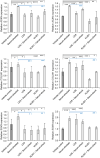A Synchronized Circadian Clock Enhances Early Chondrogenesis
- PMID: 32059614
- PMCID: PMC8804825
- DOI: 10.1177/1947603520903425
A Synchronized Circadian Clock Enhances Early Chondrogenesis
Abstract
Objective: Circadian rhythms in cartilage homeostasis are hypothesized to temporally segregate and synchronize the activities of chondrocytes to different times of the day, and thus may provide an efficient mechanism by which articular cartilage can recover following physical activity. While the circadian clock is clearly involved in chondrocyte homeostasis in health and disease, it is unclear as to what roles it may play during early chondrogenesis.
Design: The purpose of this study was to determine whether the rhythmic expression of the core circadian clock was detectable at the earliest stages of chondrocyte differentiation, and if so, whether a synchronized expression pattern of chondrogenic transcription factors and developing cartilage matrix constituents was present during cartilage formation.
Results: Following serum shock, embryonic limb bud-derived chondrifying micromass cultures exhibited synchronized temporal expression patterns of core clock genes involved in the molecular circadian clock. We also observed that chondrogenic marker genes followed a circadian oscillatory pattern. Clock synchronization significantly enhanced cartilage matrix production and elevated SOX9, ACAN, and COL2A1 gene expression. The observed chondrogenesis-promoting effect of the serum shock was likely attributable to its synchronizing effect on the molecular clockwork, as co-application of small molecule modulators (longdaysin and KL001) abolished the stimulating effects on extracellular matrix production and chondrogenic marker gene expression.
Conclusions: Results from this study suggest that a functional molecular clockwork plays a positive role in tissue homeostasis and histogenesis during early chondrogenesis.
Keywords: KL001; RT-qPCR; circadian rhythm; cosine fits; in vitro chondrogenesis; longdaysin; micromass culture; molecular clock.
Conflict of interest statement
Figures







Similar articles
-
Hypoxic Conditions Modulate Chondrogenesis through the Circadian Clock: The Role of Hypoxia-Inducible Factor-1α.Cells. 2024 Mar 14;13(6):512. doi: 10.3390/cells13060512. Cells. 2024. PMID: 38534356 Free PMC article. Review.
-
Cyclic uniaxial mechanical load enhances chondrogenesis through entraining the molecular circadian clock.J Pineal Res. 2022 Nov;73(4):e12827. doi: 10.1111/jpi.12827. Epub 2022 Sep 2. J Pineal Res. 2022. PMID: 36030553 Free PMC article.
-
Development of human cartilage circadian rhythm in a stem cell-chondrogenesis model.Theranostics. 2022 May 13;12(8):3963-3976. doi: 10.7150/thno.70893. eCollection 2022. Theranostics. 2022. PMID: 35664072 Free PMC article.
-
The circadian clock: a central mediator of cartilage maintenance and osteoarthritis development?Rheumatology (Oxford). 2021 Jul 1;60(7):3048-3057. doi: 10.1093/rheumatology/keab197. Rheumatology (Oxford). 2021. PMID: 33630038 Review.
-
Involvement of Bmal1 and circadian clock signaling in chondrogenic differentiation of ATDC5 cells by fluoride.Ecotoxicol Environ Saf. 2020 Nov;204:111058. doi: 10.1016/j.ecoenv.2020.111058. Epub 2020 Jul 31. Ecotoxicol Environ Saf. 2020. PMID: 32739676
Cited by
-
The temporal transcriptomic signature of cartilage formation.Nucleic Acids Res. 2023 May 8;51(8):3590-3617. doi: 10.1093/nar/gkad210. Nucleic Acids Res. 2023. PMID: 36987858 Free PMC article.
-
Modeling human skeletal development using human pluripotent stem cells.Proc Natl Acad Sci U S A. 2023 May 9;120(19):e2211510120. doi: 10.1073/pnas.2211510120. Epub 2023 May 1. Proc Natl Acad Sci U S A. 2023. PMID: 37126720 Free PMC article.
-
Drivers of phenotypic variation in cartilage: Circadian clock genes.J Cell Mol Med. 2021 Aug;25(16):7593-7601. doi: 10.1111/jcmm.16768. Epub 2021 Jul 2. J Cell Mol Med. 2021. PMID: 34213828 Free PMC article. Review.
-
Hypoxic Conditions Modulate Chondrogenesis through the Circadian Clock: The Role of Hypoxia-Inducible Factor-1α.Cells. 2024 Mar 14;13(6):512. doi: 10.3390/cells13060512. Cells. 2024. PMID: 38534356 Free PMC article. Review.
-
Combining biomechanical stimulation and chronobiology: a novel approach for augmented chondrogenesis?Front Bioeng Biotechnol. 2023 Jun 30;11:1232465. doi: 10.3389/fbioe.2023.1232465. eCollection 2023. Front Bioeng Biotechnol. 2023. PMID: 37456723 Free PMC article. Review.
References
Publication types
MeSH terms
LinkOut - more resources
Full Text Sources
Research Materials

